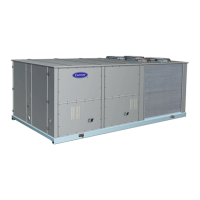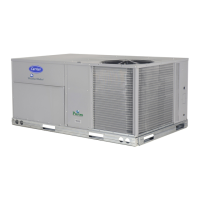89
Vent Reheat Set Point Select (
D.V.CF) — This configuration
determines how the vent reheat set point is selected. This set
point becomes the supply air set point when the Humidi-MiZer
function is initiated and the unit enters a Reheat Mode (relative
humidity above set point with no cooling demand).
D.V.CF = 0 — Reheat follows an offset subtracted from re-
turn air temperature (D.V.RA).
D.V.CF = 1 — Reheat follows a dehumidification heat set
point (D.V.HT).
Vent Reheat RAT Offset (
D.V.RA) — Set point offset used
only when the Humidi-MiZer function is initiated and the unit
enters a Reheat Mode. This occurs when the relative humidity
is above set point with no cooling demand. The air will be re-
heated to return-air temperature less this offset.
Vent Reheat Set Point (
D.V.HT) — Set point used only when
the Humidi-MiZer function is initiated and the unit enters a Re-
heat Mode. This occurs when the relative humidity is above set
point with no cooling demand. When D.V.CF = 0, the supply
air will be reheated to D.V.HT minus D.V.RA. When D.V.CF =
1, the supply air will be reheated to D.V.HT.
Dehumidify Cool Set Point (
D.C.SP) — This is the Humidi-
MiZer cooling set point used to determine the temperature the
air will be cooled to prior to it being reheated to the desired
supply-air temperature. This set point is used during the Hu-
midi-MiZer dehumidification and reheat modes of operation.
Dehumidify RH Set Point (
D.RH.S) — This is the Humidi-
MiZer relative humidity trip point.
Humidi-MiZer Adjust Rate (
HZ.RT) — This is the rate (sec-
onds) at which corrections are made in the position of the
modulating valves (C.EXV and B.EXV) to maintain supply air
set point.
Humidi-MiZer Proportional Gain (
HZ.PG) — This is the
proportional gain used in calculating the required valve posi-
tion change for supply air temperature control. It is essentially
the percentage of total reheat capacity adjustment that will be
made per degree Fahrenheit of supply air temperature error.
OPERATION
Mode Qualifications
— An HVAC: Off, Vent or Cool mode
must be in effect to launch a Humidi-MiZer mode.
Sensor Failure
— If an associated sensor responsible for con-
trolling Humidi-MiZer fails, dehumidification will not be at-
tempted (SPRH, RARH).
Initiating a Humidi-MiZer Reheat or Dehumidification
Mode — To call out a Reheat mode in the “Vent” or the “Off”
HVAC mode, or to call out a Dehumidification mode in a
“Cool” HVAC mode, one of the following must be true:
• The space is occupied and the humidity is greater than
the relative humidity trip point (D.RH.S).
• The space is occupied and the discrete humidity input is
closed.
Ending a Humidi-MiZer Reheat or Dehumidification Mode
— When either the humidity sensor falls 5% below the set
point (Configuration
DEHU
D.RH.S) or the discrete input
reads “LOW”, the Humidi-MiZer mode will end.
Relevant Outputs
— The Humidi-MiZer 3-way valve (reheat
valve) commanded output can be found in Out-
puts
COOL
RHV.
The Humidi-MiZer Condenser Modulating Valve (Con-
denser EXV) position output can be found in Outputs
COOL
C.EXV. The condenser position will be provided
as percent open.
HUMIDI-MIZER MODES
Dehumidification Mode (Subcooling)
— This mode will be
engaged to satisfy part-load type conditions when there is a
space call for cooling and dehumidification. Although the tem-
perature may have dropped and decreased the sensible load in
the space, the outdoor and/or space humidity levels may have
risen. A typical scenario might be when the outside air is 85 F
and 70 to 80% relative humidity (RH). Desired SHR for equip-
ment in this scenario is typically from 0.4 to 0.7. The Humidi-
MiZer unit will initiate Dehumidification mode when the space
temperature and humidity are both above the temperature and
humidity set points, and attempt to meet both set point require-
ments. Once the humidity requirement is met, the unit can con-
tinue to operate in normal cooling mode to meet any remaining
sensible capacity load. Alternatively, if the sensible load is met
and humidity levels remain high the unit can switch to Hot Gas
Reheat mode to provide neutral, dehumidified air.
Reheat Mode
— This mode is used when dehumidification is
required without a need for cooling, such as when the outside
air is at a neutral temperature but high humidity exists. This sit-
uation requires the equipment to operate at a low SHR of 0.0 to
0.2. With no cooling requirement and a call for dehumidifica-
tion, the N Series Humidi-MiZer adaptive dehumidification
system will cycle on enough compressors to meet the latent
load requirement, while simultaneously adjusting refrigerant
flow to the Humidi-MiZer coil to reheat the air to the desired
neutral air set point. The N Series Humid-MiZer system con-
trols allow for the discharge air to be reheated to either the re-
turn air temperature minus a configurable offset or to a config-
urable Reheat set point (default 70 F). The hot gas reheat mode
will be initiated when only the humidity is above the humidity
set point, without a demand for cooling.
System Control
— The essential difference between the De-
humidification mode and the Reheat mode is in the supply air
set point. In Dehumidification mode, the supply air set point is
the temperature required to provide cooling to the space. This
temperature is whatever the cooling control point would have
been in a normal cooling mode. In Reheat mode, the supply air
set point will be either an offset subtracted from return air tem-
perature (D.V.RA) or the Vent Reheat Set Point (D.V.HT). Both
values are configurable. For both Dehumidification mode and
Reheat mode, the unit compressor staging will decrease the
evaporator discharge temperature to the Dehumidify Cool Set
Point (D.C.SP COOL) in order to meet the latent load and re-
heat the air to the required cooling or reheat set point. There is a
thermistor array called Temperatures
AIR.T
CCT connect-
ed to the RCB. This thermistor array serves as the evaporator
discharge temperature (EDT). See Fig. 19.
The N-Series Humid-MiZer
®
system uses refrigerant flow
modulation valves that provide accurate control of the leaving-
air temperature as the evaporator discharge temperature is de-
creased to meet the latent load. As the refrigerant leaves the
compressor, the modulating valves vary the amount of refriger-
ant that enters and/or bypasses the condenser coil. As the by-
passed and hot refrigerant liquid, gas or two-phase mixture
passes through the Humidi-MiZer coil, it is exposed to the cold
supply airflow coming from the evaporator coil. The refriger-
ant is subcooled in this coil to a temperature approaching the
evaporator leaving air temperature. The liquid refrigerant then
enters an electronic expansion valve (EXV) where the refriger-
ant pressure is decreased. The refrigerant enters the EXV and
evaporator coil at a temperature lower than in standard cooling
operation. This lower temperature increases the latent capacity
of the evaporator. The refrigerant passes through the evaporator
and is turned into a superheated vapor. The air passing over the
evaporator coil will become colder than during normal opera-
tion. However, as this same air passes over the Humidi-MiZer
reheat coil, it will be warmed to meet the supply air set point
temperature requirement. See Fig. 20.
Temperature Compensated Start — This logic is
used when the unit is in the unoccupied state. The control will
calculate early Start Bias time based on Space Temperature
deviation from the occupied cooling and heating set points.
This will allow the control to start the unit so that the space is at
conditioned levels when the occupied period starts. This is

